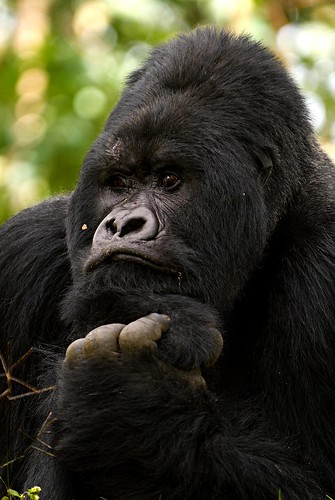2009 is the Year of the Gorilla
>> Tuesday, December 2, 2008

It's official. UN has made 2009 the Year of the Gorilla. This was done in an effort to raise awareness for this closely related to us endangered species. Initiatives include education about the animal and efforts on conserving their habitats as well. This is quite important as many experts believe that gorillas will be extinct in the wild in the next 10 years. This is believed because in the past ten years the population has dropped from 17,000 to just 5,000 in the Eastern Lowland Gorillas in the Congo. That is a frightening number. The decline is staggering and has a number of contributing factors. Conflicts, habitat loss, disease and poaching for bushmeat are some of their biggest threats.
The picture here is a Mountain Gorilla (Gorilla beringei). The species was first describe in 1847 by Thomas Staughton Savage, an American physician missionary. The males blue-black saddle (back side) turns white or silver with age, hence the term "silverbacks." Mountain Gorillas like high altitude terrains and are found in protected areas in the Democratic Republic of Congo (DRC), Rwanda and Uganda. These gentle giants are herbivorous meaning they only eat plants.
The social groupings they form are called harems. They are called such because the one or two dominant males surround themselves with unrelated females. This is unusual because in many other primates the females are all related. It is usually the kinship bonds between the females that allow for stable groups in these other primates, but in these gorillas the relationships are based purely on the individual relationships of the females to the silverback. When young gorillas reach maturity they leave the group. A young female will attach herself to another young male or find a new harem to incorporate herself into. Young males will remain solitary until they can attract females to themselves and start a harem of their own.
The mountain gorillas have some of the smallest populations of gorillas and it is estimated that between 650 and 680 individuals exist in the wild (Gray et al., 2003 and McNeilage et al., 2001).
To find out more, click the links above or go to Year of the Gorilla, Koko.org, or the Dian Fossey Gorilla Fund. Just to help you remember, Koko is the gorilla who has an amazing vocabulary in American Sign Language and Dian Fossey wrote the book Gorillas in the Mist
. The movie was based on her life.
Photo is copyright under Creative Commons Non-Commercial-Attribution License from YoungRobV's Flickr Photostream. You can find the original here.![]()












6 comments:
Don't you just love the Gorilla.....wonderful species......
I do hope, with the knowledge we have, that something can we done to help them. I think loss of habitat is my main concern.....so many species are in decline due to this......and yet man still keeps felling trees and clearing areas......so sad.......
@ Cheryl... Habitat loss does affect so many species. I wish people would realize this and quit clearing the bush.
Dear Mimi,
Gorillas are so fantastic. Glad 2009 will be an awareness year.
Sometimes I wonder what is wrong with humans we really do know better.
I am missing the butterflies at my snowy house....
My word verification is, "WOWED".
I am always wowed by you!
Sherry
@ Sherry... you always give me such undeserving compliments. Thank you so much!
In regards to your response to Sherry, just accept the compliments, you earned it and deserve it. As far as the gorillas how interesting that I can relate them to human nature.
@ The queen... thank you too. I hope we can save them.
Post a Comment